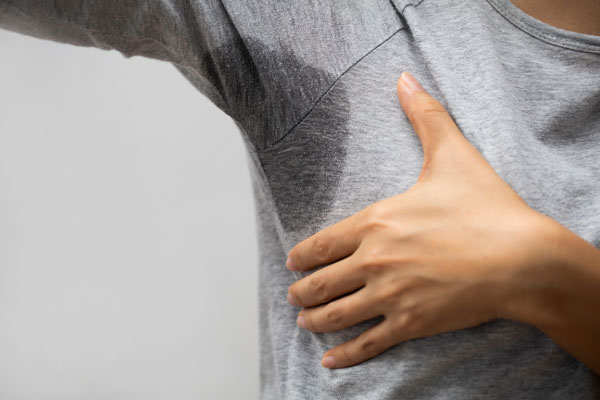
Hyperhidrosis is a condition that causes excessive sweating, which can significantly impact daily life and self-confidence. Complete Skin Specialists have options that may help to treat your condition.

Axillary hyperhidrosis describes excessive underarm sweating. It is a relatively common problem affecting around 3% of the population. It often comes on as a teenager but may occur from childhood or later in life. It may improve later in life but tends to cause severe psychological distress in teenagers and young adults. Typically sufferers describe being severely limited in what clothes they can wear and have to replace clothing very frequently.
Palmar/plantar hyperhidrosis describes excessive sweating of the palms or soles of the feet. It too can cause significant distress to sufferers and affects social interactions, such as shaking hands; footwear choices due to slippery feet and ability to complete certain tasks such as writing and fine motor work.
Hyperhidrosis usually starts in childhood or adolescence but some people first experience it as adults. The impact of this condition is often underestimated it can affect work and social situations and may cause significant psychological distress. Fortunately, effective treatments are readily available.
In most cases, hyperhidrosis happens because the body’s sweat glands are overactive. The type of sweating linked to hyperhidrosis is different from the normal sweating that helps regulate body temperature. It is usually triggered by stress, anxiety, or emotions and commonly affects the underarms, hands, and feet.
In some cases, excessive sweating can be linked to an underlying medical condition (secondary hyperhidrosis), such as thyroid issues or hormonal imbalances. If sweating occurs with other symptoms like unexplained weight loss, fevers, or night sweats, further medical evaluation may be needed.
Hyperhidrosis often occurs:
If excessive sweating is accompanied by other symptoms, such as muscle or joint pain, headaches, or unexplained fevers, it is important to consult a healthcare professional.
There are several treatment options available, depending on the severity of sweating and the areas affected:
Depending on where you’re at in your journey, you can book an appointment with our dermatology practice, or cosmetic practice.
Depending on individual circumstances, treatment options may include:
39 Station Street, Sunbury VIC 3429
Depending on individual circumstances, treatment options may include Botulinum toxin injections.
Building 1: 115 O’Shanassy Street, Sunbury VIC 3429
If you’re a new patient, you’ll be invited to attend an initial consult prior to your service to ensure it’s right for you.

See your GP to obtain a referral

Initial consult to discuss
skin concerns and goals

Receive a treatment plan to support your skin health

Expertise

Long Lasting Results

Healthier Skin
